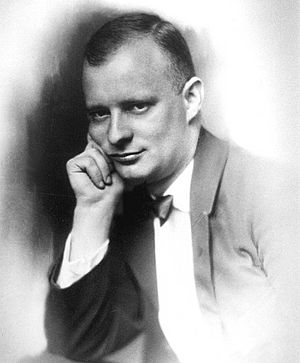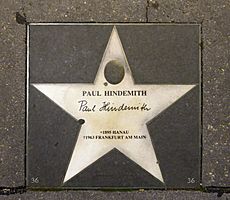Paul Hindemith facts for kids
Quick facts for kids
Paul Hindemith
|
|
|---|---|

Paul Hindemith in 1923
|
|
| Born | 16 November 1895 |
| Died | 28 December 1963 (aged 68) |
| Education | Dr. Hoch's Konservatorium |
| Occupation |
|
| Organization |
|
|
Works
|
Compositions |
| Awards |
|
Paul Hindemith (born November 16, 1895 – died December 28, 1963) was a very important German composer. He was also a music theorist, a teacher, a violist, and a conductor. He started a music group called the Amar Quartet in 1921. They traveled all over Europe.
As a composer, he was a big supporter of a music style called Neue Sachlichkeit (new objectivity) in the 1920s. Some of his famous pieces include Kammermusik, which features instruments like the viola. He also wrote the song cycle Das Marienleben (1923) and the opera Mathis der Maler (1938). Another well-known work is the Symphonic Metamorphosis of Themes by Carl Maria von Weber (1943).
Contents
Early Life and Musical Beginnings
Paul Hindemith was born in Hanau, a town near Frankfurt, Germany. He was the oldest child in his family. Paul started learning to play the violin when he was young.
He went to the Dr. Hoch's Konservatorium in Frankfurt. There, he studied violin, conducting, and how to compose music. To earn money, he played in dance bands and musical-comedy groups. In 1914, he joined the Frankfurt Opera Orchestra. He became the main violinist, or concertmaster, in 1916.
Hindemith During World War I
In 1917, Paul Hindemith joined the German army. He was sent to a place called Alsace. There, he played the bass drum in the army band. He even started a string quartet with other soldiers.
Later, he was sent to the front lines in Flanders. He wrote in his diary about how lucky he was to survive grenade attacks. After the war ended, he went back to Frankfurt.
Becoming a Famous Composer
In 1921, Hindemith started his own music group, the Amar Quartet. He played the viola in this group. They traveled and performed all over Europe, becoming very well known.
New Music Styles
In the 1920s, Hindemith became a leader in a music style called Neue Sachlichkeit. This means "new objectivity." His pieces like Kammermusik are examples of this style. These works often featured solo instruments like the viola. They reminded people of the music of Johann Sebastian Bach.
In 1922, some of his music was played at a festival in Salzburg. This helped him become known around the world. The next year, he started helping to organize the Donaueschingen Festival. He invited many new and experimental composers to perform there.
In 1927, he became a professor at the Berliner Hochschule für Musik in Berlin.
Film Music and Other Works
Hindemith wrote music for a unique film called Ghosts Before Breakfast in 1928. He even acted in the movie! Sadly, the original music and film were later destroyed by the Nazis. The music was later recreated in 2006.
In 1929, he played the solo part in a new viola concerto by William Walton.
On May 15, 1924, Hindemith married Gertrud Rottenberg. She was an actress and singer. They did not have any children.
Hindemith and the Nazis
The relationship between the Nazis and Hindemith's music was complicated. In 1934, a high-ranking Nazi official, Joseph Goebbels, publicly called Hindemith an "atonal noisemaker." This meant his music was seen as too modern and not traditional enough.
In 1936, the Nazis banned his music. He was even included in a 1938 exhibition called "Degenerate Music." This exhibition showed art and music that the Nazis disliked. However, some other Nazi officials thought Hindemith could be a good example of a modern German composer. This was because his music was becoming more traditional. The famous conductor Wilhelm Furtwängler even defended Hindemith in public.
Moving Away from Germany
Because of the problems with the Nazis, Hindemith visited Cairo and Ankara, Turkey, many times in the 1930s. In 1935, he accepted an invitation from the Turkish government. He helped create a music school in Ankara. He played a big role in changing music education in Turkey.
In 1938, he moved to Switzerland. One reason was that his wife had some Jewish family background. He then moved to the United States in 1940.
Teaching and Later Life
In the U.S., Hindemith mainly taught at Yale University. He started the Yale Collegium Musicum there. Many of his students became famous composers and musicians. He also taught at other universities like Harvard. During this time, he wrote a book called A Composer's World.
Hindemith became a U.S. citizen in 1946. But in 1953, he moved back to Europe. He lived in Zürich, Switzerland, and taught at the university there until 1957. Later in his life, he started conducting more often. He made many recordings, mostly of his own music.
In 1955, Hindemith received the Wihuri Sibelius Prize. In 1962, he won the Balzan Prize. This award recognized his rich and varied musical work.
Paul Hindemith continued to compose almost until he died. He passed away in Frankfurt at the age of 68.
Hindemith's Musical Style
Paul Hindemith is considered one of the most important German composers of his time. His early music was in a late Romantic style. Then he wrote some expressionist pieces. Later, in the 1920s, he developed a clearer, more complex style. This style is sometimes called neoclassical. It was inspired by composers like Johann Sebastian Bach.
Unique Instruments and Ensembles
His new style can be heard in his series of works called Kammermusik (Chamber Music). These pieces were written between 1922 and 1927. Each piece is for a different small group of instruments. Many of these groups were very unusual. For example, Kammermusik No. 6 is a concerto for the viola d'amore. This instrument had not been widely used since the Baroque period. Hindemith himself played it.
He continued to write for unusual instrument groups throughout his life. He wrote a trio for viola, heckelphone, and piano in 1928.
Operas and Orchestral Works
Around the 1930s, Hindemith started writing more for large orchestras. In 1933–35, he wrote his opera Mathis der Maler. This opera is about the life of the painter Matthias Grünewald. Before writing the opera, Hindemith wrote a symphony also called Mathis der Maler. This symphony is one of his most popular works.
Music for Everyday Use
Hindemith also wrote Gebrauchsmusik, which means "Music for Use." These were pieces meant to have a social purpose. Sometimes, they were written for amateur musicians to play. An example is his Trauermusik (Funeral Music) from 1936. He wrote this piece quickly for solo viola and string orchestra. It was a tribute to King George V, who had just died.
Other examples of his Gebrauchsmusik include:
- Wir bauen eine Stadt ("We’re Building a City"), an opera for eight-year-olds (1930).
Popular Works
Hindemith's most popular work is probably the Symphonic Metamorphosis of Themes by Carl Maria von Weber. He wrote it in 1943. It takes melodies from different works by Weber and changes them. Each part of the piece is based on one of Weber's themes.
In 1951, Hindemith finished his Symphony in B-flat. This piece was written for a concert band. It is a very important piece in the band repertoire.
Awards and Honors
- Howland Memorial Prize (1940)
- Elected to American Academy of Arts and Sciences (1940)
- Bach Prize of the Free and Hanseatic City of Hamburg (1951)
- Order Pour le Mérite (1952)
- Wihuri Sibelius Prize (1955)
- Goethe Plaque of the City of Frankfurt (1955)
- Elected to the American Philosophical Society (1962)
- Balzan Prize (1963)
Honorary Degrees
- Philadelphia Academy of Music (1945)
- Columbia University (1948)
- Goethe University Frankfurt (1949)
- FU Berlin (1950)
- Oxford University (1954)
Pedagogical Writings
Paul Hindemith wrote several books to teach music. Here are some of them:
- Elementary Training for Musicians (1946)
- A Concentrated Course in Traditional Harmony: Book 1 (1968)
- A Concentrated Course in Traditional Harmony: Book 2 (1964)
- The Craft of Musical Composition: Book 1—Theoretical Part (1942)
- The Craft of Musical Composition: Book 2—Exercises in Two-Part Writing (1941)
Recordings
Hindemith conducted some of his own music for recordings. He worked with famous orchestras like the Philharmonia Orchestra and the Berlin Philharmonic Orchestra. These recordings have been put on CDs. He also conducted his piece When Lilacs Last in the Dooryard Bloom'd with the New York Philharmonic Orchestra.
See also
 In Spanish: Paul Hindemith para niños
In Spanish: Paul Hindemith para niños
- Music written in all major and/or minor keys



